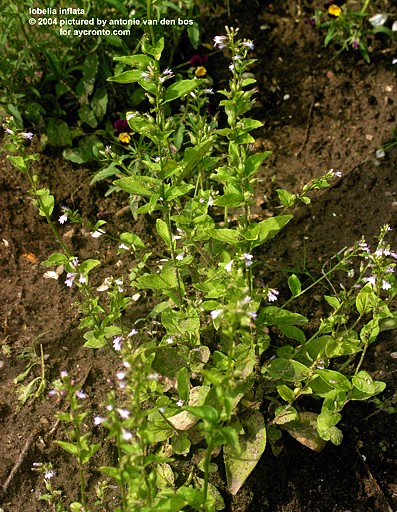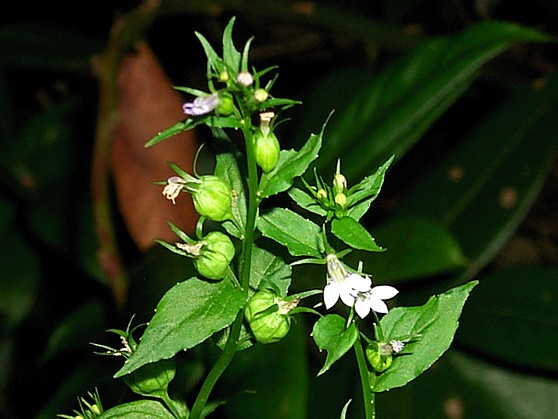Lessico
Mathias
de Lobel
Mathias de L'Obel

Mathias
(1538-1616) si firmava de L’Obel, latinizzato in Lobelius. Nacque
nel 1538 a Lille, attuale capoluogo del dipartimento del Nord, che corrisponde
grosso modo alla Fiandra francese. A quei tempi Lille faceva parte dei Paesi
Bassi e gli ascendenti di Lobelius erano di origine belga. All’età di 16
anni Mathias era già attratto dalla botanica e dalla medicina, ma solo nel
1565 (quindi a 27 anni, e il perché non è documentato) si immatricolò nella
scuola di medicina di Montpellier. Divenne lo studente favorito di Guillaume
Rondelet![]() e dopo
che il suo maestro morì nel 1566 rimase altri tre anni a Montpellier dove
conseguì la laurea in medicina.
e dopo
che il suo maestro morì nel 1566 rimase altri tre anni a Montpellier dove
conseguì la laurea in medicina.
Praticò la professione medica ad Anversa dal 1571 al 1581 e quindi a Delft fino al 1584 dove era medico del Principe di Orange. Dopo l’assassinio di Guglielmo I detto il Taciturno avvenuto nel 1584, lasciò i Paesi Bassi per recarsi in Inghilterra dove rimase per il resto della vita, morendo a Londra nel 1616. Divenne superintendente del giardino botanico fondato a Hakcney da Lord Zouch che accompagnò in un’ambasceria alla Corte di Danimarca nel 1592. Fu anche Botanico Reale sotto Giacomo I che lo insignì del titolo di botanografo.
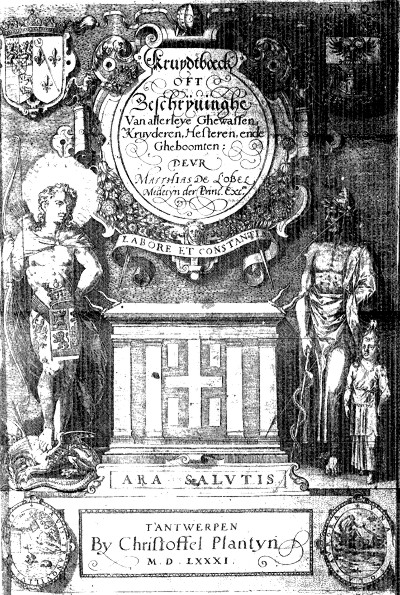
Il suo Stirpium adversaria nova (1571, scritto con Pierre Pena) è una delle pietre miliari della botanica moderna. Successivamente lo Stirpium observationes, una sorta di complemento agli adversaria, venne unito alla prima opera che assunse il nome di Plantarum seu stirpium historia (1576). I lavori botanici di L’Obel avevano come scopo l’impiego terapeutico delle piante e nel 1605 pubblicò uno studio sulla farmacologia di Rondelet che venne incluso in una riedizione degli adversaria.
Per i suoi
meriti Charles Plumier![]() , valoroso botanico di Marsiglia (1646-1706), gli dedicò il genere Lobelia
, valoroso botanico di Marsiglia (1646-1706), gli dedicò il genere Lobelia![]() ,
delle regioni calde. La Lobelia inflata, dell'America Settentrionale,
è usata in farmacia per il suo contenuto in lobelina; Lobelia erinus,
del territorio del Capo, in Africa meridionale, è coltivata nei giardini.
,
delle regioni calde. La Lobelia inflata, dell'America Settentrionale,
è usata in farmacia per il suo contenuto in lobelina; Lobelia erinus,
del territorio del Capo, in Africa meridionale, è coltivata nei giardini.
La lobelina è un alcaloide che costituisce il più importante principio attivo della Lobelia inflata, ed è dotata di una potente azione stimolante sui centri respiratori; agisce inoltre sui gangli prima in senso eccitatorio poi come paralizzante, con meccanismo analogo a quello della nicotina. A dosi elevate provoca il vomito, convulsioni e paralisi della muscolatura volontaria. Sotto forma di cloridrato viene adoperata in medicina come analettico respiratorio e nella disassuefazione al tabacco.
![]()
Mathias de l'Obel (ou de Lobel ou Lobelius) est un botaniste flamand, né en 1538 à Lille et mort le 3 mars 1616 à Highgate en Grande-Bretagne. De l'Obel étudie à Montpellier auprès de Guillaume Rondelet qui le tient en haute estime. Il pratique la médecine de 1571 à 1581 à Anvers et à Delft où il est le médecin du prince d'Orange En 1584, il quitte les Pays-Bas pour y fuir la guerre civile et gagne le Royaume-Uni où il demeurera jusqu'à sa mort. Charles Plumier lui a dédié le genre Lobelia (de la famille des Campanulaceae).
Il est le superintendant du jardin botanique de Hackney fondé par Lord Zouch. Il devient également le botaniste du roi auprès de Jacques Ier. En collaboration avec Pierre Pena (dont on ignore tout), il fait paraître son Stirpium adversaria nova en 1571 et en 1576, Plantarum seu stirpium historia, qui sera traduit en flamand, en 1581, sous le titre de Kruydboeck.
Dans son Stirpium, l'Obel décrit environ 1 500 espèces de façon précise avec indication des localités où les espèces ont été récoltées: c'est une véritable flore des environs de Montpellier mais décrit aussi des plantes du Tyrol, de Suisse et de Hollande. Cet ouvrage est accompagné de 268 gravures sur bois de petites tailles.
Le second, Plantarum seu stirpium historia est plus qu'une simple adaptation du premier avec un index en sept langues et plus de 2 000 illustrations (dont la plupart sont tirées des ouvrages de Clusius, de Rembert Dodoens et de Pierandrea Mattioli. De l'Obel le dédicace à la reine Élisabeth Ire. Il est imprimé par Christophe Plantin et connaît un grand succès. On y trouve aussi un embryon de classification plus réussie que chez les auteurs précédents: il réunit avec justesse les roseaux, les graminées et les céréales mais aussi, dans un autre groupe les trèfles et les oxalis à cause de leurs feuilles subdivisées en trois.
Lobelia is a genus of flowering plant comprising 360–400 species,
with a subcosmopolitan distribution primarily in tropical to warm temperate
regions of the world, a few species extending into cooler temperate regions.
English names include Lobelia, Asthma Weed, Indian Tobacco, Pukeweed, and
Vomitwort.
Some botanists place the genus and its relatives in the separate family Lobeliaceae,
others as a subfamily Lobelioideae within the Campanulaceae. The
Angiosperm Phylogeny Group did not make a firm decision in this, listing the
genus under both families.
Lobelia is probably the base form from which many other lobelioid genera are derived; it is therefore highly paraphyletic and not a good genus. For example, the Hawaiian species are part of a group including other genera that appear very different (see Hawaiian lobelioids). However, the group has not yet been studied adequately to rearrange the classification.
Lobelia species are used as food plants by the larvae of some Lepidoptera species including Setaceous Hebrew Character. The genus is named after the Belgian botanist Matthias de Lobel (1538-1616).
Selected species
Lobelia aberdarica
Lobelia anatina – Southwestern Blue Lobelia
Lobelia anceps
Lobelia appendiculata
Lobelia assurgens
Lobelia berlandieri
Lobelia boykinii
Lobelia canbyi
Lobelia cardinalis (syn. L. fulgens) – Scarlet Lobelia
Lobelia chinensis
Lobelia comosa
Lobelia coronopifolia
Lobelia deckenii
Lobelia dortmanna
Lobelia erinus – Edging Lobelia
Lobelia
flaccidifolia
Lobelia flaccida
Lobelia gaudichaudii
Lobelia gerardii
Lobelia gibberoa
Lobelia ilicifolia (syn. L. purpurascens) – Purple Lobelia
Lobelia inflata – Indian Tobacco
Lobelia kalmii
Lobelia keniensis
Lobelia laxiflora – Sierra Madre Lobelia
Lobelia leschenaultiana
Lobelia monostachya
Lobelia nicotianifolia
Lobelia niihauensis
Lobelia oahuensis
Lobelia persicifolia
Lobelia pinifolia
Lobelia puberula
Lobelia pyramidalis
Lobelia rhombifolia
Lobelia rosea
Lobelia sessilifolia
Lobelia siphilitica
Lobelia spicata
Lobelia telekii
Lobelia tenuior
Lobelia thapsoidea
Lobelia tupa
Lobelia urens
Lobelia valida
Lobelia zeylanica
Several species are cultivated as ornamental plants in gardens. These include Lobelia cardinalis (Cardinal Flower or Indian Pink), Lobelia siphilitica (Blue Lobelia), Lobelia fulgens and Lobelia erinus, as well as some hybrids.
Lobelia erinus, a South African annual plant is often grown in window boxes and hanging baskets. Many varieties have been cultivated with a wide variety of colours. In the Victorian language of flowers, the lobelia symbolizes malevolence and ill will.
Native
Americans used Lobelia to treat respiratory and muscle disorders, and
as a purgative. Today it is used to treat asthma and food poisoning, and is
often used as part of smoking cessation programs. It is a physical relaxant,
and can serve as a nerve depressant, easing tension and panic. The species
used most commonly in modern herbalism is Lobelia inflata (Indian
Tobacco).
Extracts of Lobelia inflata contain Lobeline, which showed positive
effects in the treatment of multidrug-resistant tumor cells. Furthermore,
Lobeline can be modified to Lobelane which decreased methamphetamine
self-administration in rats. It therefore opens a perspective in
Methamphetamine-dependency treatment.
As used in North America, Lobelia's medicinal properties include the following: emetic (induces vomiting), stimulant, antispasmodic, expectorant, diaphoretic, relaxant, nauseant, sedative, diuretic, and nervine. Because of its similarity to nicotine, the internal use of Lobelia may be dangerous to susceptible populations, including children, pregnant women, and individuals with cardiac disease. Excessive use will cause nausea and vomiting. It is not recommended for use by pregnant women and is best administered by a practitioner qualified in its use.
Two species, Lobelia siphilitica and Lobelia cardinalis, were considered a cure for syphilis. Herbalist Samuel Thompson popularized medicinal use of lobelia in the United States in the early 1800s, as well as other medicinal plants like goldenseal.
Lobelia erinus
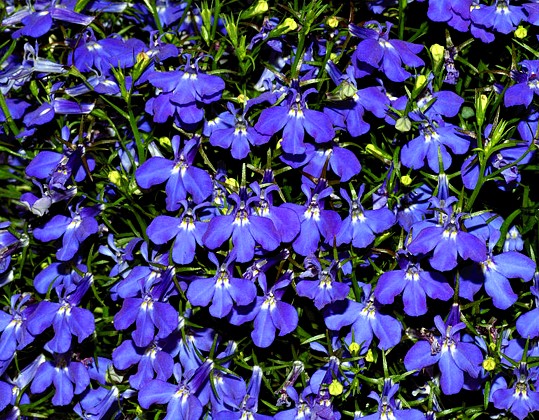
Lobelia erinus (Edging Lobelia, Garden Lobelia or Trailing Lobelia) is a species of Lobelia native to southern Africa, from Malawi and Namibia south to South Africa. It is a prostrate or scrambling herbaceous perennial plant growing to 8–15 cm tall. The basal leaves are oval, 10 mm long and 4-8 mm broad, with a toothed margin; leaves higher on the stems are slender and sometimes untoothed. The flowers are blue to violet in wild plants, with a five-lobed corolla 8–20 mm across; they are produced in loose panicles. The fruit is a 5–8 mm capsule containing numerous small seeds.
Lobelia erinus is a very popular ornamental plant in gardens, grown for its long flowering period, from mid spring to early autumn. It is perennial in subtropical climates, but often grown as an annual plant in colder areas. Numerous cultivars have been selected for garden use, with a wide range of flower colours, including white, pink, red, pale to dark blue, and purple. Some of the better known cultivars are 'Blue Moon', 'Cascade', 'Gracilis' and 'Rosamund'.
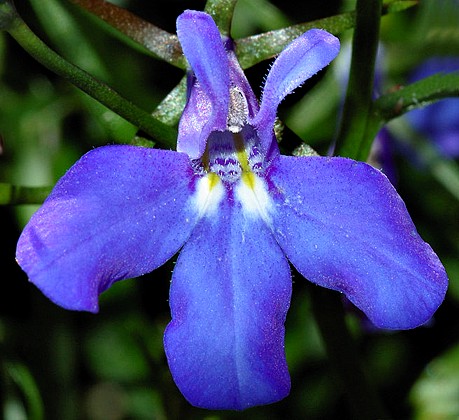
Lobelia inflata
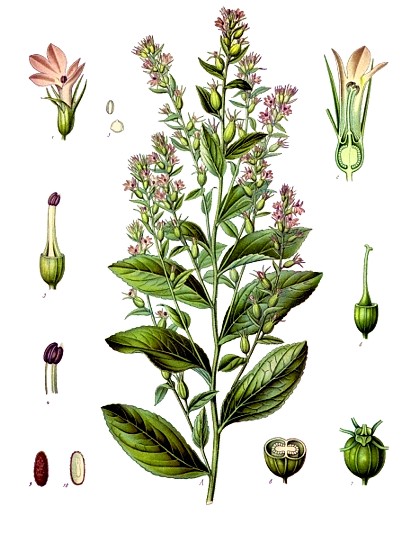
Lobelia inflata (Indian Tobacco) is a species of Lobelia native to eastern North America, from southeastern Canada (Nova Scotia to southeast Ontario) south through the eastern United States to Alabama and west to Kansas. It is an annual or biennial herbaceous plant growing to 15–100 cm tall, with stems covered in tiny hairs. Its leaves are usually about 8 cm long, and are ovate and toothed. It has violet flowers that are tinted yellow on the inside, and usually appear in mid summer and continue to bloom into fall.
Lobelia inflata has a long use as an entheogenic substance. The plant was widely used by the Penebscot Indians and was widely used in the New England even before the time of Samuel Thomson who was credited as discovering it. Indian Tobacco is still used today. The most potent part of the plant is the seed as it contains the most lobeline, the main ingredient which gives the plant its pyschoactive property. It is sold widely in online herbal shops, and is prized among ethneogen users. Its taste is reminiscent of real tobacco, acrid and burning, and it promotes the heavier flow of saliva. A common misconception is that when smoked it yields a euphoric "high" like feeling, when it actually produces a more relaxant like effect. It can be used fresh, or dry.
Lobelia inflata is also used by herbalists for treatment of asthma, hence its other nickname, asthma weed. Some make ointments of the plant to use externally. It is also said that plant material is burned as a natural bug repellent to keep away insects such as mosquitoes.
Propagation is usually accomplished by cuttings or seed. Seeds are sown in containers in mid spring or mid fall. The seeds take about 2 weeks to germinate.
